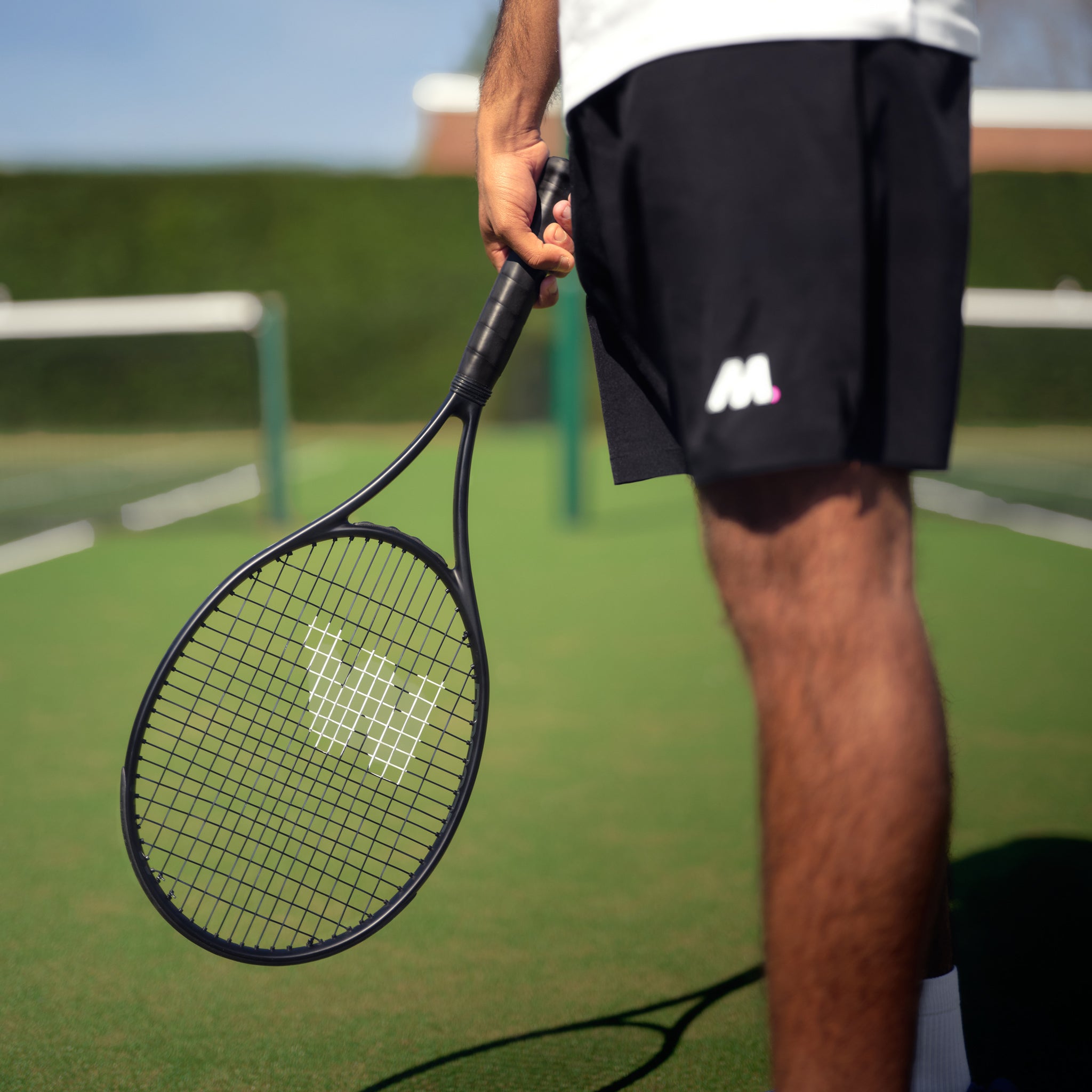
This tennis string guide will walk you through everything that matters: materials, construction, tension, and gauge. At Mantis, our goal is to help you find that perfect match.
Choosing the right tennis string is about more than just picking a product off the shelf. At Mantis, we believe it’s about understanding the delicate balance between power, control, comfort, and durability—and finding the precise combination that clicks with your racquet and your unique style of play.
Your Essential Tennis String Guide
Welcome to the definitive guide from Mantis. It’s easy for players to get obsessed with their racquet frame, but the real heart of your on-court performance lies in the strings. Think about it: they’re the only part of your racquet that ever actually touches the ball. This makes them the single most critical component influencing your power, control, and feel.
Diving into the world of tennis strings can feel a bit overwhelming at first, but it doesn't have to be. We're here to demystify the key differences between materials, constructions, and tensions, showing you how small, informed adjustments can genuinely transform your game. We believe an informed player is an empowered player.
Why Strings Matter So Much
Think of your racquet frame as a car's chassis and the strings as its engine and tyres all rolled into one. A high-performance chassis is worthless without an engine that can deliver the right amount of horsepower and tyres that grip the road. In the same way, your strings are what dictate exactly how the ball behaves the moment it leaves your racquet.
A great string setup can:
- Boost your power on serves and groundstrokes.
- Sharpen your control for pinpoint accuracy on volleys and drop shots.
- Enhance spin generation to make your shots dip and curve aggressively.
- Improve comfort by absorbing harsh vibrations and reducing strain on your arm.
Ultimately, choosing the right strings isn't about finding the "best" string on the market; it's about finding the best string for you.
The Growing Importance of String Technology
The sheer scale of the global tennis string market shows just how vital this piece of equipment is. It was valued at USD 1.5 billion in 2023, with synthetic options like polyester leading the charge due to their incredible durability and spin potential. The market is projected to grow to an estimated USD 2.7 billion by 2033, fuelled by constant innovation from manufacturers.
Here in the UK, you see a clear split in preferences. Many club and recreational players lean towards comfortable multifilaments, while competitive players often gravitate towards polyester for its uncompromising performance.
At Mantis, we see strings not as an accessory, but as a fundamental piece of performance equipment. By the end of this guide, you will have the confidence and knowledge to select the perfect strings that work in harmony with your racquet and playing style.
Decoding String Materials and Construction
To pick the right string, you have to know what it’s made of. At Mantis, we know it's the most fundamental decision you can make to tailor your racquet's performance, as different materials give you completely different results on the court.
Here at Mantis, we aim to guide players through this often confusing world by keeping things simple. We’ve even put together our definitive Mantis guide to tennis racket strings for those who want to dive even deeper. Think of string materials like ingredients in a recipe—the final dish depends entirely on what you put in.
Broadly speaking, strings fall into two main families: Natural Gut and Synthetics. Each has a unique construction that directly impacts how it feels, how long it lasts, and how much power it delivers. Getting your head around these core differences is the first step toward a setup that actually helps your game.
Natural Gut: The Gold Standard for Feel
For decades, natural gut has been the undisputed benchmark for playability and comfort. It’s crafted from the serous membranes of cow intestines through a complex process that results in a string with incredible elasticity and tension retention. This unique makeup allows it to pocket the ball like nothing else, giving you a level of feel and touch that synthetics are still trying to replicate.
So, why do so many pros still use it, often in a hybrid setup? It all comes down to its unmatched performance.
- Superior Playability: It gives you a deeply connected feel, perfect for executing delicate drop shots and precise volleys.
- Excellent Tension Maintenance: Natural gut holds its tension better than almost any other string, meaning your racquet plays consistently for longer.
- Unmatched Comfort: Its natural elasticity is incredibly arm-friendly, absorbing shock and helping to reduce the risk of tennis elbow.
The main downsides are its higher cost and its historical weakness to moisture, though modern coatings have made it much more resilient. For players who value feel and comfort above everything else, natural gut is still in a class of its own.
The Diverse World of Synthetic Strings
While natural gut sets the standard for feel, synthetic strings offer a huge range of options designed for specific needs like durability, spin, and affordability. They generally fall into three categories: Polyester, Multifilament, and Synthetic Gut, each built to achieve a different goal.
This is where understanding tension becomes crucial. The material you choose heavily influences how your racquet feels at a specific tension, which a stringer carefully calibrates.

As you can see, setting the right tension is a precise art. It’s what ultimately defines your racquet's balance of power and control, a choice that starts with the string material itself.
To help you navigate these choices, here’s a quick comparison of the most common materials.
Comparing Key Performance of Tennis String Materials
This table offers a quick-glance comparison of the key performance characteristics of common tennis string materials, helping you identify the best fit for your needs.
| Material | Primary Benefit | Best For | Durability | Comfort Level |
|---|---|---|---|---|
| Natural Gut | Feel & Power | All-court players, touch artists | Moderate | Highest |
| Polyester | Control & Spin | Aggressive baseliners with fast swings | Highest | Lowest |
| Multifilament | Comfort & Power | Players with arm issues or seeking easy power | Low-Moderate | High |
| Synthetic Gut | All-Round Playability | Recreational players, beginners | Moderate | Medium |
Ultimately, this table simplifies a complex decision. Your perfect string is the one that best matches your playing style, physical needs, and performance goals.
Polyester (Poly): The Engine of the Modern Game
Think of a polyester string as a single, solid piece of durable plastic. This monofilament construction makes it stiff and firm, which is exactly what players with long, fast swings need to control their power. Its main benefit is undeniable: control.
The firmness of poly lets you swing for the fences without worrying about the ball sailing long. Plus, its slick surface encourages fantastic "snap-back," where the strings slide and then violently snap back into place on impact, generating massive topspin.
Because polyester strings are so firm, they offer incredible durability and control. However, this stiffness also means they lose tension relatively quickly and can be harsh on the arm, making them best suited for competitive players without arm sensitivities.
Multifilament: For Comfort and Power
If poly is a solid wire, then a multifilament is like a rope made of hundreds or even thousands of tiny, flexible microfibres twisted together. This construction is engineered specifically to mimic the comfortable and powerful response of natural gut.
These strings are much softer than polyesters, providing excellent shock absorption. This makes them a fantastic choice for players with arm trouble or those looking for more effortless power. The trade-off for all that comfort? Lower durability. The fibres will eventually fray and break, much faster than a solid poly string.
Synthetic Gut: The All-Rounder
Positioned as the budget-friendly, do-it-all option, synthetic gut usually has a solid core wrapped with one or more layers of outer filaments. This construction delivers a good blend of playability, power, and durability.
It’s a reliable workhorse for a huge range of recreational and club players. While it doesn't stand out in any single category the way poly does for control or multifilament does for comfort, it offers dependable all-around performance at a great price. For many, it's the perfect first string.
How Tension and Gauge Fine-Tune Your Game
Once you’ve settled on the right string material, the real customisation begins. At Mantis, we know you can think of tension and gauge as the fine-tuning dials on your racquet. They’re what turn a good string choice into a great one, allowing you to precisely calibrate power, control, and feel to match your unique game.
At Mantis, we often see players unlock a whole new level of performance just by tweaking these settings. It’s that important. If you want to go even deeper, we’ve put together a full breakdown of how tennis strings tension works.
Getting a grip on these concepts isn't just for the pros; it's for anyone serious about improving their game. A slight adjustment in tension can be the difference between a forehand that clips the line and one that sails an inch long. In the same way, picking the right string thickness can completely change how connected you feel to the ball at impact.
The Power vs. Control Equation of Tension
String tension is simply the force used to pull the strings into the racquet frame, measured in pounds (lbs) or kilograms (kg). The relationship between this number and how your racquet performs is one of the most fundamental concepts in tennis.
At its core, it's an inverse relationship:
- Lower Tension = More Power
- Higher Tension = More Control
Why? It all comes down to the trampoline effect. Lower tension strings stretch more on impact, absorbing the ball’s energy before catapulting it back with extra speed. This is fantastic for players who need a bit of help generating depth or want some "free" power without having to swing out of their shoes.
On the other hand, higher tension stiffens the string bed and limits that trampoline effect. The ball spends less time on the strings, giving you a more direct, predictable response. This is perfect for players with fast, full swings who already generate plenty of pace and need maximum control to paint the lines.
A common tension range for most racquets falls between 48 and 60 lbs. But with the rise of stiff polyester strings, many advanced players are now stringing at much lower tensions—sometimes dipping into the low 40s—to claw back some comfort and feel.
Finding Your Ideal Tension
So, where do you start? A good rule of thumb is to begin right in the middle of your racquet's recommended tension range, which is usually printed somewhere on the frame. From there, it's all about adjusting based on what you feel on court.
Here are a few player profiles to think about:
- The Baseline Grinder: This player might lean towards a lower tension (say, 50-54 lbs) to help them consistently hit deep, heavy groundstrokes and wear down opponents.
- The Net Specialist: Someone who loves to serve-and-volley might opt for a higher tension (around 55-59 lbs) for that crisp, responsive feel needed for delicate touch volleys and sharp angles.
- The Player with Arm Issues: To maximise comfort, this player should go for the lowest viable tension, often paired with a soft multifilament string, to drastically reduce shock and vibration.
Understanding String Gauge
The second dial you can turn is gauge, which is just a fancy word for the string's thickness. It's a bit counter-intuitive, but in the world of tennis, a lower gauge number means a thicker string, while a higher number means a thinner one.
Most strings range from 15 (thickest) to 18 (thinnest), with half-sizes like 16L or 17L giving you in-between options. The choice here is a classic trade-off between playability and durability.
Thinner Strings (e.g., 17g, 1.25mm or 18g, 1.20mm)
- Pros: They "bite" into the ball more effectively, which seriously enhances spin. Their added elasticity also gives you a much better feel and a bit more pop.
- Cons: The trade-off is durability. They will break more quickly, plain and simple.
Thicker Strings (e.g., 16g, 1.30mm or 15g, 1.35mm)
- Pros: Their main selling point is durability. They last longer and are the go-to choice for chronic string-breakers. They also tend to offer a little more control because they are less powerful.
- Cons: They can feel stiffer and offer less spin potential and feel compared to their thinner cousins.
Choosing the right gauge is a balancing act. If you live for spin and feel and don't mind restringing a bit more often, a thinner gauge is a phenomenal choice. If you’re a big hitter who’s tired of popping strings every few matches, a thicker gauge will give you the longevity you need.
Using Hybrid Stringing to Customise Performance
Ever felt like your string setup is almost perfect, but just missing something? At Mantis, we know the feeling. Maybe you love the spin of your polyester strings but your arm doesn't. Or you adore the buttery feel of natural gut but can't stomach the price tag or the frequent restringing.
This is exactly why hybrid stringing exists. It’s not just a niche technique for pros; it’s a powerful way for any player to get exactly what they want from their racquet. Think of it like being your own stringbed chef, blending ingredients to create the perfect recipe for your game. The concept is simple: use one type of string for the mains (vertical) and a different type for the crosses (horizontal).
Here at Mantis, we see it as a game-changer. By mixing and matching, you can craft a combination that delivers a unique blend of comfort, spin, durability, and feel—something a full bed of a single string could never quite achieve.
The Logic Behind Hybrid Combinations
So, how does it work? It all comes down to understanding the roles of the main and cross strings. The mains are the star of the show. They run vertically, parallel to the handle, and do most of the moving, sliding, and snapping back on impact. They define the racquet’s dominant characteristics—its feel, its spin potential, its overall response.
The crosses are the supporting act. They weave through the mains, influencing the overall stiffness of the stringbed and controlling how much the mains can move. They add flavour, nuance, and balance.
The most popular setup, often called the "pro's hybrid," puts this logic into practice beautifully. It combines a durable, spin-friendly polyester string in the mains with a softer, more feel-oriented natural gut or multifilament in the crosses.
Here’s the thinking behind it:
- Mains (Polyester): The stiff, slick polyester is your engine for control and spin. In the modern game, you need a string that can grab the ball and snap back into place to generate heavy topspin. This is the poly’s job.
- Crosses (Natural Gut/Multifilament): This is where the magic happens. The softer cross strings cushion the impact, taking the harsh edge off the polyester. This makes the whole setup far more comfortable and arm-friendly, while also adding a touch of power and responsiveness that a full bed of poly often lacks.
It's a perfect partnership. You get the tour-level spin and control from the poly mains without the unforgiving, board-like feel. Each string compensates for the other's weaknesses.
By blending different string materials, hybrid stringing lets you address specific needs. For instance, you can get 80% of the performance benefit of a full bed of expensive natural gut by using it in just the crosses, saving you money while keeping a premium feel.
Popular Hybrid Recipes for Every Player
While the poly/gut combo gets all the headlines, the possibilities are nearly endless. You can design a hybrid to fix almost any problem or enhance any strength. In the UK, we've seen a real surge in players asking for customised hybrid setups. It makes sense—the UK tennis equipment market, valued at around USD 150.45 million in 2024, shows a strong preference for gear that blends durability with playability.
Let's look at a few "recipes" to get you started.
For the Power Player Seeking Durability
- Mains: Thick Gauge Polyester (e.g., 16g/1.30mm)
- Crosses: Thinner Gauge Polyester (e.g., 17g/1.25mm)
- Why it Works: This "durability hybrid" uses two gauges of the same material. The thicker mains create a rock-solid foundation for control and a longer lifespan, while the thinner crosses allow for a bit more string movement, giving you better spin without a huge drop-off in durability.
For the All-Courter Seeking Comfort and Control
- Mains: Polyester (e.g., Mantis Power Polyester)
- Crosses: High-Quality Multifilament (e.g., Mantis Comfort Synthetic)
- Why it Works: Think of this as the club player’s version of the pro hybrid. You get that great spin and control from the polyester mains, but the multifilament crosses provide fantastic comfort and a little extra pop on your shots. It’s a wonderfully well-rounded and arm-friendly setup.
For the Touch Player Wanting More Spin
- Mains: Natural Gut or a Soft Multifilament
- Crosses: A shaped or rough-textured Polyester
- Why it Works: Now we’re flipping the script with a "reverse hybrid." By putting the softest string in the mains, you maximise feel, comfort, and power—the hallmarks of a touch player's game. The textured polyester cross strings then bite into the mains, adding a surprising amount of spin potential to an otherwise classic-feeling setup.
Right then, let's talk about the most personal part of your racquet: the strings. At Mantis, we believe finding the perfect string setup isn’t about some universal formula you can look up online. It’s about figuring out your own personal equation, one that balances your game, your racquet, and your body.
At Mantis, our goal is to help you connect the dots between string theory and what actually happens on the court. We want the choices you make to genuinely improve your game. Think of this as the practical part of our guide, where we help you figure out what kind of player you are and match your strings accordingly.
The real secret is realising your strings and racquet are a team. They absolutely have to complement each other. For example, a stiff, modern power frame often feels incredible when paired with a softer, more comfortable string that soaks up some of the shock and adds a bit of feel. On the other hand, if you use a classic, flexible player's frame, a crisp polyester string can add a layer of control and precision you might be missing. That synergy is what turns a good setup into a great one.
For the Aggressive Baseliner
If your game is built around hitting heavy, powerful groundstrokes from the back of the court, you have one main goal: to wrap all that power in a blanket of control and spin. You’re already generating your own pace with long, fast swings, so you need a string that can help you tame the ball and make it dive down with vicious topspin.
This kind of player almost always gravitates towards a full bed of polyester string. The natural stiffness of a poly monofilament gives you the control to swing out confidently, without that nagging fear of the ball sailing long. Its slick surface is also the magic behind "snap-back," which is the secret sauce for generating the heavy, modern spin that makes your shots so difficult to handle.
- Recommended String Type: Polyester (Poly).
- Ideal Tension: You'll want to go for the lower end of the recommended range, around 48-52 lbs. This gives a firm string bed a little more pop and pocketing, stopping it from feeling like you're hitting with a plank of wood.
- Gauge Choice: A thinner gauge (17g/1.25mm) will give you a noticeable boost in spin, while a thicker gauge (16g/1.30mm) is a smarter choice if you're a chronic string breaker, as it will last longer.
For the All-Court Strategist
The all-court player is a master of variety, seamlessly switching from powerful baseline rallies to delicate touch shots at the net. You need a string setup that can do a bit of everything—offering enough control for baseline battles, enough feel for drop shots and volleys, and just enough power to put the ball away when you get the chance.
This is where hybrid stringing really comes into its own. The classic "pro's hybrid" is an absolutely brilliant choice for this style.
By putting a durable polyester string in the mains (the vertical strings) and a softer multifilament or natural gut in the crosses (the horizontal ones), you get the best of both worlds. The poly gives you the spin and control for your groundstrokes, while the softer cross string adds the comfort and touch you need for your net game.
This combination creates a versatile and dynamic stringbed that feels ready for any situation you find yourself in on the court.
Recommended Setups:
- Option 1 (Performance Focus): Polyester mains with Natural Gut crosses. This is the elite setup, offering an unmatched blend of control, spin, feel, and tension stability.
- Option 2 (Balanced & Arm-Friendly): Polyester mains with a high-quality Multifilament cross. This gives you very similar benefits to the pro hybrid, but it's more affordable and exceptionally comfortable.
For the Player with Arm Sensitivity
If you've ever dealt with tennis elbow or just general arm soreness, your string choice becomes less about tweaking performance and more about self-preservation. Your number one priority is comfort. You need to minimise the shock and vibration that travels up your arm on impact, which means stiff, harsh strings are your worst enemy.
Your best bet here is a full bed of the softest string you can get your hands on. Natural gut is the undisputed king of comfort. Its incredible elasticity is second to none, but that quality comes with a premium price tag. A top-tier multifilament string is a fantastic and much more affordable alternative, as they are engineered specifically to feel and play like natural gut.
- Recommended String Type: Multifilament or Natural Gut.
- Ideal Tension: Go low. You should aim for the bottom of your racquet's recommended range, or even slightly below, often around 45-50 lbs. Lowering the tension reduces the stiffness of the stringbed, which dramatically cuts down on shock.
- What to Avoid: Whatever you do, steer clear of a full bed of polyester. The stiffness can be brutal on a sensitive arm and is likely to make any existing issues worse.
Matching Strings to Your Racquet Specs
Finally, you can't ignore the racquet itself. Its own characteristics should have a huge say in your string choice. The trick is to work with your frame, not against it.
| Racquet Specification | Impact on String Choice | Recommendation Example |
|---|---|---|
| Head Size | Larger head sizes (100+ sq. in.) are naturally more powerful. | Tame that power by pairing it with a control-focused string like polyester. |
| Stiffness (RA Rating) | A stiff frame (RA 68+) gives you lots of easy power but can feel harsh. | A soft multifilament or a hybrid setup will add much-needed comfort and feel. |
| String Pattern | An open pattern (e.g., 16x19) grips the ball for more spin but breaks strings faster. | A thicker gauge or a durable poly string will help you get more life out of your setup. |
| Flexibility (RA Rating) | A flexible frame (RA below 64) has great feel but doesn't provide much "free" power. | Add some easy pop by using a powerful multifilament or a lower-tension poly. |
When you put it all together—your playing style and your racquet's specs—you build a complete system where every part is working in harmony. That’s how you unlock your best tennis.
Knowing When and Why to Restring Your Racquet
Getting the right strings in your frame is a massive step forward, but that’s only half the battle. At Mantis, we know that knowing when to cut them out is just as important for keeping your game sharp. We need to bust a common myth right now: you don’t wait until a string snaps to get a restring. The truth is, your strings start dying long before they break.
This process is called tension loss, and it’s the silent killer of control and feel.
Every time you hit a ball, your strings stretch. It’s what they’re designed to do. But over time, they lose their elasticity and ability to snap back into place. They become ‘dead’. This loss of life robs you of power, makes your shots feel unpredictable, and can even lead to arm fatigue as you start swinging harder just to get the same result. Good string maintenance isn’t just about gear; it’s about protecting your arm and letting you play your best tennis.
The Restringing Rule of Thumb
If you're not sure where to start, there’s a brilliantly simple rule of thumb that works for most club players.
As a general guideline, you should restring your racquet as many times per year as you play per week. So, if you play three times a week, plan on restringing your racquet at least three times a year—even if the strings are still intact.
This simple formula helps keep your stringbed fresh and responsive. It’s a proactive way to look after your equipment that pays huge dividends on the court, preventing that slow, creeping decline in performance that comes from playing with dead strings.
Of course, this is just a starting point. If you’re an aggressive baseliner, a frequent string-breaker, or a fan of stiff polyester strings, you’ll need to restring far more often. For some, that could be after just 10-15 hours of play. On the flip side, a casual player using a soft multifilament might get a little more life out of their set. The key is to listen to your racquet.
Clear Signs It's Time for a Fresh Set
Beyond the rule of thumb, your strings will give you clear signals when they’re past their best. Learning to spot these signs means you can act before your game starts to suffer. You’re looking for clues you can see and changes you can feel.
What to Look For:
- Deep Notching: This is the most obvious sign. Take a look at where your main strings and cross strings intersect. If the mains have deep grooves sawn into them, they can no longer slide and snap back. Your spin potential has just plummeted.
- Fraying: You’ll mainly see this on multifilament and natural gut strings. Fraying is a dead giveaway that the string's internal fibres are breaking down. A full snap is just around the corner.
- Dull and Dirty: Fresh strings have a certain life and vibrancy to them. When they start to look dull, discoloured, and grimy, it’s a good indication their best days are long gone.
What to Feel For:
- Loss of Control: Are your shots suddenly sailing long for no apparent reason? Dead strings create an inconsistent, overly powerful trampoline effect, making it incredibly difficult to control the ball's depth.
- A "Dead" or "Mushy" Sensation: If that crisp, clean feeling at impact has been replaced by a vague, mushy thud, your strings have lost their tension and pop. The connection to the ball is gone.
- Increased Vibration: Fresh strings are great at absorbing shock. When they go dead, you’ll likely notice more vibration and an unpleasant buzzing sensation travelling up your arm.
Paying attention to these little details ensures you’re always playing with a racquet that helps your game, not hinders it.
Your Top Tennis String Questions, Answered
Diving into the world of tennis strings can feel a bit like a rabbit hole. At Mantis, we've seen that the more you learn, the more questions pop up about how every little detail impacts your game. At Mantis, we think clarity is the key to confidence, so we’ve put together answers to some of the most common queries we hear from players just like you.
Let's get straight to it. A question we get all the time is: "How long do new strings take to 'settle'?"
Think of a fresh string job like a new pair of shoes—it needs a little breaking in. You can expect a new set of strings to take about 1-2 hours of hitting to really settle. During that first session or two, the initial tension will drop slightly and then stabilise. You'll notice the stringbed starts to feel more consistent and predictable. This is especially true for polyester strings, which benefit hugely from this initial settling period.
Another hot topic is what to do about tension when you’re mixing different types of strings.
Should I Use Different Tensions for Hybrid Stringing?
Yes, absolutely. In fact, it’s not just common, it’s a smart tactic used by experienced players and stringers. When you create a hybrid setup—let’s say a firm polyester in the main strings and a softer multifilament or natural gut in the crosses—it’s a great idea to drop the tension on the softer cross string.
Most stringers recommend lowering the cross string tension by about 2-4 lbs compared to the mains.
This technique, often called differential tensioning, is all about creating balance. It prevents the softer string from over-stretching and losing its character too quickly, giving you a much more playable and harmonious feel right from the first ball you hit.
It’s a small tweak, but it can make a massive difference to the feel and lifespan of your hybrid setup.
Can the Same String Feel Different in Another Racquet?
Without a doubt. A string's personality is massively shaped by the racquet it’s in. That crisp, controlled polyester you love in your flexible, 98-square-inch frame could feel like a stiff, unforgiving board in a larger, more powerful racquet.
It all comes down to the racquet's own specs. The big three are:
- Head Size: A bigger head size creates longer strings, which makes the stringbed feel softer and adds a dose of free power.
- Stiffness (RA Rating): A stiffer frame (higher RA) will make any string feel firmer and more direct on impact.
- String Pattern: An open pattern like 16x19 allows for more string movement and a livelier, spin-friendly feel, while a dense 18x20 pattern will feel more controlled and solid.
This is exactly why you have to consider your racquet’s DNA when trying out a new string. And for those of us creating guides like this one, it’s just as important to understand what connects with our audience. To make sure content provides long-term value, it's crucial to track content performance and see what's resonating.
Finally, what about pre-stretching? It’s a bit of an old-school practice that depends on the string. While it was once common for natural gut, today's modern multifilaments and polyesters are engineered to perform best when strung straight from the packet.
At Mantis, our passion is crafting expertly designed equipment that helps you chase your goals on court. We invite you to explore our full range of performance strings to find the perfect partner for your game.








